0079
Kerstin Eleonora Kohl*
Pädagogische Hochschule Freiburg, University of Education, Freiburg, Germany
Abstract
In view of the increasing number of cases of plagiarism and the ease of use of on-line published texts, universities are faced with a considerable challenge to prevent and take action against plagiarism in academic student papers. In reaction to plagiarism, web-based plagiarism detection systems (PDSs) are increasingly used to check submitted papers – this checking entails various problems, for example the percentage of plagiarism found is only an indication of the actual extent of plagiarism and not all types of plagiarism can be identified.
To cope with this problematic situation the voluntary plagiarism check (VPC), an alternative preventive university didactic concept, was developed at the University of Education, Freiburg (Germany). It focused on the development of individual skills. Students were able to submit their academic papers (e.g. an undergraduate paper, final thesis) anonymously. These were then tested with the PDS Ephorus. Following interpretation and summary of the findings by the project team – plagiarism as well as referencing mistakes – we advised the students on a suitable approach to academic writing based on their own typical mistakes. The VPC was conducted as a three-semester research project and was later evaluated. About 500 academic papers were tested. In 90% of the undergraduates’ work incorrect and/or missing citations were found. This high percentage decreased among students in later semesters. Instances of plagiarism were detected in about 40% of the papers when the texts of advanced students (≥6th semester) were tested. At the same time the length of the plagiarised texts decreased.
Around half of the students stated that it was acceptable to copy single sentences or short passages from other sources without citation; they did not consider plagiarising on a limited scale as cheating. A similar number of students admitted to having doubts about whether they could write a good paper without plagiarising. Almost all students said that they had experienced considerable uncertainty, stress and fear while writing academic papers. The project results offer new insights into Internet-focused working strategies, on student justification for plagiarism and attitudes to literary property and on frequent mistakes. In addition to showing that there is broad acceptance among students of the VPC, the results can be taken into consideration in curriculum development and in developing courses to meet the needs of students.
Keywords: voluntary plagiarism check; universitiy didactic concept; plagiarism check of academic papers
*Corresponding author. Email: kohl@ph-freiburg.de
(Received 17 May 2011; final version received 11 June 2011; Published: 31 August 2011)
ISBN 978-91-977071-4-5 (print), 978-91-977071-5-2 (online)
2011 Association for Learning Technology. © K.E. Kohl. This is an Open Access article distributed under the terms of the Creative Commons Attribution-NonCommercial-NoDerivs 2.0 UK: England & Wales licence (http://creativecommons.org/licenses/by-nc-nd/2.0/uk/) permitting all non-commercial use, distribution, and reproduction in any medium, provided the original work is properly cited.
DOI: 10.3402/rlt.v19s1/7611
Plagiarism is dishonest and as such is academic misconduct. The intellectual property of third persons is ignored in practising plagiarism. Academic writing requires the ability to use the correct academic style for the citation and acknowledging of sources. Students should be able to apply what they have learned in the teaching context to their own research and publication practice. The increase in incorrect documentation practice goes hand in hand with the increase in use of on-line material – in fact we are dealing with the problem of ‘e’-plagiarism. Our daily experience shows that many students use the Internet to borrow texts and ideas without mentioning the sources. They claim this on-line material as their own work. Weber (2009) refers to this phenomenon as the “copy & paste culture”. Studies show that 25–60% of students plagiarise (e.g., Greubel 2009; McCabe 2005; Scanlon and Neumann 2002; Szabo and Underwood 2004; Weber 2009). For a current literature review on the academic (dis)honesty of college students, see Payan, Reardon, and McCorkle (2010).
In the context of academic learning, the Internet serves as a source of information and a means of communication, participation, collaboration and social networking. The addition of the prefix ‘e’ necessitates changes in teaching practices. It is not just a question of applying existing learning skills to an electronic medium. With the establishment of e-learning contexts, universities expect students to become more active knowledge-designers in individualised, self-determined learning processes. This “shift from teaching to learning” (Welbers and Gaus 2005) raises the expectation that university didactic concepts will support such a change of the entire teaching and learning culture. In order to achieve a move towards learner-centred teaching and learning, on-line-based didactic concepts have to cover the whole qualification process, including the resulting academic papers. Given that when plagiarism occurs, it is mostly a case of copying & pasting Internet content (Weber 2009); this (mal)practice must be viewed and treated as common'e’-plagiarism. Therefore, the detection of such plagiarism is usually carried out by means of a text comparison with on-line sources. This means we are dealing with a challenge in the field of media-supported teaching and learning and their didactics. In order to find concepts for prevention, the focus must be on finding out which specific features of on-line-culture encourage plagiarism.
Attention should be paid to the variety of reasons for plagiarism, ranging from deliberate to unintentional acts (Evans 2006; Kohl 2010). In Figure 1, an overview of the possible causes is given (summarised from Bowman 2004; Greubel 2009; McCabe, Klebe Treviño, and Butterfield 2005; Weber 2009). The findings show that in many papers lack of knowledge, poor academic sensitisation and false perceptions of the purpose and readership of the paper of the writing cause the errors and omissions. In view of our particular university didactic perspective we focused on a concept of prevention: the aspects in Figure 1 with a white background.
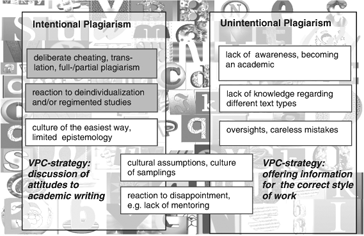
Figure 1.
Possible reasons for plagiarism.
There are some didactic approaches which can help prevent unintended plagiarism such as giving students the opportunity to self-check their academic papers by using a plagiarism detection system (PDS). Students themselves can use the technical systems to check their papers. Such procedures receive positive feedback from the students themselves (e.g. Dahl 2007). However, it is questionable whether students can acquire honest academic working strategies and learn correct citation by merely receiving a technical detection report. In the report, errors are not self-explanatory and there is no opportunity to explain or to discuss inappropriate attitudes. However, feedback and advice from academic staff seems to result in changes in the writing process and the acquisition of ethical norms (Engler and Landau 2011).
[…] if a campus decides to address academic dishonesty by creating a social norms campaign, then the campaign must use the most credible source of information. […] our results indicate that students are attentive to the source of these messages and may use this information, in part, to determine their behavioral response to the normative message they receive. Efforts to identify and use credible sources (perhaps professors) to share messages about the true levels of academic dishonesty will contribute to more successful social norms campaign outcomes. (Engler and Landau 2011, 48)
Bringing the subject of plagiarism up for discussion and evaluating different types of plagiarism consistently is a difficult undertaking for colleges. There is disagreement among academic staff regarding what constitutes academic honesty with regard to using and acknowledging sources – in the evaluation of student performance as well as in their own writing behaviour (Bennett, Behrendt, and Boothby 2011). This hinders the development of a common teaching concept across different faculties.
Plagiarisms are mostly produced out of ignorance and only rarely intentionally. Measures to avoid plagiarisms should rather be aimed at explaining and instructing the correct action than at repression. (Dannenberg 2009, 133, translated by author)
With this project we achieved a change of perspective: from general suspicion to an opportunity to develop skills. Our central aim was to raise awareness and allow students to gain additional qualifications, so that they take responsibility and carry out future academic work fairly.
Our main questions while carrying out and evaluating the research project (using descriptive statistics as well as formative and summative evaluation methods) were:
Is a facility such as the VPC system suitable to support the transfer from the teaching context to personal academic practice? Is there a demand for this among students?
Which types of plagiarism and/or mistakes in referencing and the acknowledgement of sources exist at our college, and to what extent? How do students explain their academic writing process? Which factors do students list as affecting their behaviour?
A general atmosphere of trust on the part of university lecturers in the honest working methods of their students as well as responsibility on the part of students cannot be achieved in an atmosphere of general suspicion or by means of a routine test of all academic papers by using a PDS. The concept of the project voluntary plagiarism check (VPC) should be viewed as one possible alternative or a complement to other didactic concepts with the aim of prevention.
In the three semesters up to February 2011, a VPC of students’ academic papers (term paper, undergraduate or final thesis) was implemented and evaluated at the University of Education in Freiburg, Germany www.ph-freiburg.de. The university offers programmes of study in education. Eighty per cent of the students are undertaking initial teacher training. BA/MA degree courses in health education and promotion, economics education, media education, early years education and adult education are also available. Undergraduate degrees typically take three to four years to complete. Graduates of all courses will most likely work in the field of education. This means that they may act as role models when it comes to handling intellectual property. The project was based at the Centre for Media Literacy (medien∣kompetenz∣zentrum, www.ph-freiburg.de/mkz, and run by the author.
Using the Internet-based PDS Ephorus www.ephorus.com, students were able to have their work checked anonymously. They could either send the project team their paper by email or bring a file (*.doc, *.rtf, *.pdf) stored on a USB memory stick during office hours. After plagiarism detection and interpretation of the PDS-report they receive personal feedback and, if necessary, useful concrete advice for the practical application in academic communication and writing as well as background information concerning ethical and epistemic background issues. Examples drawn from students’ texts in the PDS report were used to generate feedback.
The students were able to choose between a personal consultation and summarised feedback by mail. The students did not receive the full PDS report. This was to prevent the PDS reports from being used to check whether intentional plagiarism would be detected when the paper was submitted to faculty. At the same time, we wanted to encourage students to revise the paper on their own with the help of the examples provided. It became clear that certain mistakes appeared repeatedly. It therefore proved useful to give advice based on well-chosen examples. In our study, about 500 academic papers were checked for plagiarism and mistakes in citing and this was followed by a consultation. Directly after the consultation, the VPC service was evaluated by the students. An on-line questionnaire with standardised and open questions was used https://www.soscisurvey.de/plagiatskontrolle.
With the aim of statistical capture, the text characteristics of every submitted paper were recorded by the project team (e.g. type of paper submitted, mistakes found, types of plagiarism, subject area). Descriptive results could be derived from this data, for example, frequency of plagiarism, type of quoting mistakes (see research question (1)).
From analysis of this questionnaire we obtained information about:
students’ motives for cheating, for using the VPC, for their writing process,
self-assessment of writing skills, habits in the use of on-line material and their underlying epistemologies,
course of study, year of study (see research question (2)) and
assessment of the didactic concept and the actual performance of VPC, their suggestions for improvement (see research question (1)).
We established that students from all courses and all departments used VPC. This is shown in Figure 2. Depending on the size of individual departments, the number of papers submitted varied. It was interesting to establish that plagiarism and/or citing mistakes did in fact take place in subject areas where academic staff had denied this would happen due to subject-specific circumstances. We were able to show that the incorrect use of sources is present in all departments and that students from all departments have a need for advice.
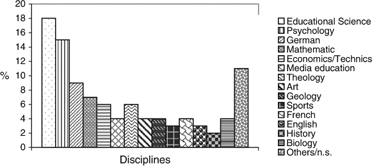
Figure 2.
Disciplines using the VPC.
Regarding the kind of academic papers that were submitted (Figure 3) one can see that mainly final theses were tested with VPC (60%). Term papers were 37% and 3% were dissertations as well as other types of texts we could not identify.
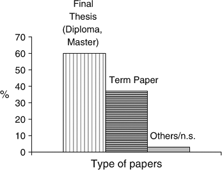
Figure 3.
Type of papers submitted.
It is difficult to identify and prove plagiarism without technical support. Comparison is often time-consuming and, therefore, cost-intensive. Noticeable changes in writing style, unusual choice of words or ‘brilliant ideas’ sometimes indicate plagiarism – but the original sources are often not identifiable or traceable, as in the case of translated texts, for example. A PDS allows for quick and easy detection – by comparison with on-line material and with a bank of previously checked files – with no extra effort. The PDS compares a paper with millions of others on the Internet. The document is simultaneously checked for matches with any papers submitted to that system in the past. The results are displayed in a summarised report. The ease of use of this technical search solution makes it of particular interest to universities. The software can be integrated in existing learning management systems.
We have to consider what level of reliability can be achieved by a PDS. The result of plagiarism checking contains information about correspondences with other text sources. The percentage of agreement between the detected source and the original source is shown along with the associated URL (Figure 4 and 5). Every match has to be evaluated – not every match is a plagiarism. In fact, in many cases corresponding parts were in fact not plagiarism, e.g. matches due to careless mistakes in quoting sources, definitions or legitimate quotes from classical literature, as shown in Figure 5. The PDS indicates plagiarism, but cannot prove it. The detected text parts become plagiarism only by the interpretation of the lecturer. When both plagiarism and mistakes are present, as in the example, it is not easy to decide.
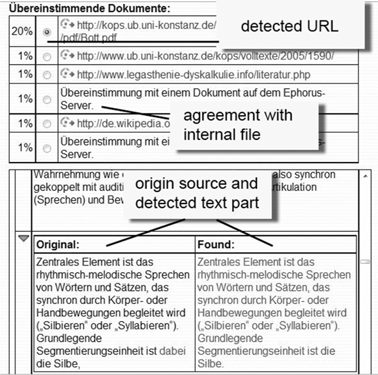
Figure 4.
Screenshot, detailed results.
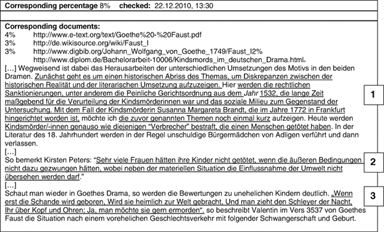
Figure 5.
Printable result of plagiarism detection via PDS Ephorus.
Only a small number of plagiarism types can be identified by a PDS – it is limited to verbatim plagiarism of more than 10 consecutive words. These detected sentences mostly originate from on-line material, available free, the extracts rarely come from printed or fee-based publications. It is not possible to detect plagiarism based on translations, mosaic plagiarism, adopting the pattern or structure of arguments and ideas, alterations, paraphrasing and restructured parts of a text. Self-plagiarism or submitting someone else's work cannot be identified either.
In our experience, mostly mixed forms of plagiarism appeared in the papers checked. In the event of detection of ‘e’-plagiarism it is very likely that other types of plagiarism may occur too and/or that text extracts from printed publications have been borrowed as well.
To sum up, a PDS is not a miracle solution to detect plagiarism, but it is extremely helpful as long as teachers and lecturers know how to interpret the findings. They also have to be aware that if no plagiarism was found by the PDS, this does not automatically mean that there was no plagiarism at all in the paper submitted. Precisely, because it is not a miracle solution, but it was available for use in the context of the preventive didactic methods shown in this article.
The work in Figure 5 was an original part of a checked undergraduate thesis. Underlined passages correspond to sections in source documents, URLs are given at the top. Sub-section 1: real plagiarism with some words substituted; parts were borrowed from a BA thesis. Sub-section 2: citation (‘Kirsten Peters said “Sehr viele...”’) without date or page reference. Perhaps this was a mistake because the source is listed in the reference list. Or it might be borrowed from the BA thesis too, because the citation itself appears in the thesis as well. In this case, the student would not have actually read the article written by author Kirsten Peters. Sub-section 3: a correct textual component, a verse from Johann Wolfgang von Goethe's Faust.
Personally, I used the VPC to make sure that I made no mistakes, even though I really feel relatively secure in citation. The theme of correct academic writing is rarely discussed in courses. So, the VPC is a good way to make up to for this. At the end of the long writing-process I was so confused. I really didn't know if I had overlooked errors in some kind of inaccurate work and I didn't remember the sources of some passages either. This was not deliberate plagiarism and the VPC gives me the chance to eliminate these errors before submitting my paper. With the feedback I got I feel more confident now. I spent a lot of time on literature review and research. After a certain point, it is difficult to distinguish between your own thoughts and the intellectual property of others. So the VPC is very helpful! (Student, mail feedback 2009; translated by author)
At this point it should be emphasised that the following results may not be generalised to the general occurrence of plagiarisms at our university or to the overall attitudes, writing habits and knowledge of all students. It is assumed that a sub-group of students with a background of particular interests and knowledge used VPC. We reached about 10% of the students at our university with our service. For this sub-population of students we can determine that the VPC was suitable for their aims and useful as a complementary qualification. It was rated as very helpful and graded very highly. The most commonly cited reasons for using VPC were (1) fear of negative consequences in the case of mistakes, (2) awareness of gaps in one's own knowledge, (3) insecurity in the face of inconsistent information for correct academic writing (e.g. citing styles), (4) high level of conscientiousness because of planned academic career and (5) compensation for the lack of input on correct academic writing in the academic disciplines.
(1) Occurrence of plagiarism and quoting mistakes: plagiarism, intentional as well as accidental, exists in all text forms and appears in every discipline. In the academic papers of students in their first three semesters of study, we found a large number of plagiarism and quoting mistakes (90% of examined papers). Mostly, longer excerpts were copied from sources, which were not cited at all or cited in an incomplete/erroneous way.
This high instance of plagiarism decreased as students progressed through their studies. From the 6th semester to degree-level, quoting mistakes and plagiarism ‘only’ occurred in about 40% of the papers. Also, the length of the excerpts used clearly decreased. This might be seen as progress in learning. Or it may be that with the increasing differentiation in studies and specialisation in research questions, the probability of discovering text conformities may decrease: it was not possible to integrate as much Internet content as in the academic papers written by students in early semesters.
(2) Self-assessment of academic writing: there is great uncertainty about correct academic writing and considerable pressure when composing one's own texts. Ninety-one per cent of students said that they had had problems, ranging from fear and stress (not being good enough at the subject, writing something wrong, difficulties in expressing their own ideas, time pressure/cognitive overload, unforeseen mistakes in form and content type) to loss of motivation (lack of interest in the topic, lack of mentoring by lecturers, lack of explanations about honest academic practices). About 30% of the students assumed the submitted papers were not read thoroughly by lecturers.
About 50% stated ‘it is acceptable to borrow single sentences or shorter passages from texts without citing’, about 25% admitted to plagiarising in this way and to doing this regularly.
Two-thirds of students learned the correct use of sources on their own, some learnt correct academic writing from peers, only 20% said that they received explicit instruction about honest academic practices in lectures or seminars at university. One-third stated that they acquired knowledge about citing incidentally.
(3) Evaluation of the VPC: 95% of students who had used VPC indicated having used it to reduce insecurity and in particular the fear of poor marks (50%). Twenty-one per cent wanted to compensate deficits in their studies by utilising the consultation – this type of motive can be labelled as ‘self-determined prevention’. These students were motivated to learn the correct method of citing. In addition, we interpreted intended plagiarism in the occurrence of several large matching text passages (>15% of the content) in single papers. Sometimes students presented plagiarism with text correlations >85%, mainly borrowed from on-line-buyable sources for academic theses. Three per cent of the students presenting such papers tried to use VPC to check whether the deliberately plagiarised paper would be identified when submitted to faculty. (In fact, they were disappointed that we could not give them this assurance. Perhaps this is the reason why in the last semester of the project not a single paper of this kind was presented to the team.)
We found there was broad acceptance of the VPC. It was evaluated very positively with the grade 1, sehr gut (equivalent of a grade A). All students were keen that VPC should be set up as a regular service in the future. In particular, the personal feedback given with examples from their own text was considered extremely helpful. In addition, it was suggested by students that feedback and advice should be available more quickly – it sometimes took two or three days until the results were available due to technical issues.
The frequent cases of plagiarism at universities were a convincing reason for implementing the university didactic concept of the Voluntary Plagiarism Control. We viewed ‘e’-plagiarism as an opportunity to discuss attitudes, to gain knowledge as well as to establish a basis for curricular development in teaching academic integrity and, in particular, correct citing and honest use of sources. With the VPC authentic and significant learning becomes possible. This kind of situated learning ties in with the concept of autonomous learning and thus reflects the idea of on-line based teaching at universities in general. The findings of other authors cited above on the various causes of plagiarism Figure 1 – of which a large number do not lead to deliberate plagiarism – were confirmed for the sub-group of students using VPC. We assume that students in general often have difficulties in academic writing and many of them plagiarise intentionally or unintentionally. To address this issue the VPC has been available as a permanent service at the Centre for Media Literacy since March 2011.
Currently, a detailed artefact analysis of the submitted papers is in preparation. We would like to explore aspects of the ontogeny of academic writing competences (Pohl 2007) concerning the prevalence of plagiarism, also in correlation with research competences and epistemic relief (Pohl and Steinhoff 2010).
Bennett, K.K., L.S. Behrendt, and J.L. Boothby. 2011. Instructor perceptions of plagiarism: Are we finding common ground? Teaching of Psychology 38, no. 1: 29–35.
Bowman, V. ed. 2004. The plagiarism plague – A resource guide and CD-Rom-tutorial for educators and librarians.. New York: Neal-Schuman.
Dahl, S. 2007. Turnitin®: The student perspective on using plagiarism detection software. Active Learning in Higher Education 8: 173–191.
Dannenberg, D. 2009. »Das kurze Leben des S.B. Preuss« oder: Zitieren und Belegen in Bibliothekskursen. In Wissensklau, Unvermögen oder Paradigmenwechsel? Plagiate als Herausforderung für Lehre, Forschung und Bibliothek [Cheating, nescience or paradigm shift? Plagiarism as accepted challange at universities, research and librarianship], R. Barth, N. Böller et al., 133–142. Chur: Arbeitsgemeinschaft Informationswissenschaft.
Engler, J.N., and J.D. Landau. 2011. Source is important when developing a social norms campaign to combat academic dishonesty. Teaching of Psychology 38, no. 1: 46–48.
Evans, R. 2006. Evaluating an electronic plagiarism detection service. The importance of trust and the difficulty of proving students don't cheat. Active Learning in Higher Education 7, no. 1: 87–99.
Greubel, R. 2009. Vom Fehlverhalten zum Plagiator – fördert das Internet den Wissensklau? In Wissensklau, Unvermögen oder Paradigmenwechsel? Plagiate als Herausforderung für Lehre, Forschung und Bibliothek [To give an opportunity to learn? Voluntary Plagiarism Check of students academic papers]. , R. Barth, N. Böller et al., 1–11. Chur: Arbeitsgemeinschaft Informationswissenschaft.
Kohl, K.E. 2010. Im Zweifel für die Lernchance? Freiwillige Plagiatskontrolle wissenschaftlicher Arbeiten. In Digitale Medien für Lehre und Forschung [To give an opportunity to learn? Voluntary Plagiarism Check of students academic papers], ed. S. Mandel, M. Rutishauser and E. Seiler Schiedt, 415–27. Waxmann.
McCabe, D.L., L. Klebe Treviño, and K. Butterfield. 2005. Cheating in academic institutions: A decade of research. Ethics & Behavior 11, no. 3: 219–232.
McCabe, D.L. 2005. Cheating among college and university students: A North American perspective. International Journal for Educational Integrity 1: 1.
Payan, J., J. Reardon, and D.E. McCorkle. 2010. The effect of culture on the academic honesty of marketing and business students. Journal of Marketing Education 32: 275–291.
Pohl, T. 2007. Studien zur Ontogenese wissenschaftlichen Schreibens [Ontogenesis of academic writing]. Tübingen: Niemeyer.
Pohl, T., and T. Steinhoff. 2010. Textformen als Lernformen. Kölner Beiträge zur Sprachdidaktik (KöBeS) 7.
Scanlon, P.M., and D.R. Neumann. 2002. Internet plagiarism among college students. Journal of College Student Development 43, no. 3: 374–385.
Szabo, A., and J. Underwood. 2004. Cybercheats. Is Information and Communication Technology fuelling academic dishonesty? Active Learning in Higher Education 5, no. 2: 180–199.
Weber, Stefan. 2009. Das Google-Copy-Paste-Syndrom. Wie Netzplagiate Ausbildung und Wissen gefährden [The google-copy-and-paste-syndrome. Internetplagiarism endanger the quality of study and apprenticeship]. Hannover: Heise.
Welbers, U., and O. Gaus. 2005. The shift from teaching to learning. Konstruktionsbedingungen eines Ideals. Bielefeld: W. Bertelsmann.